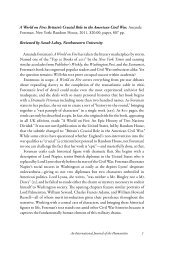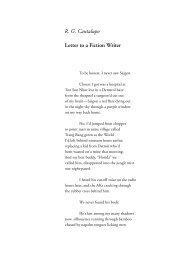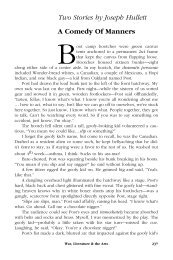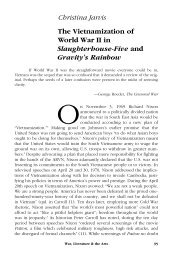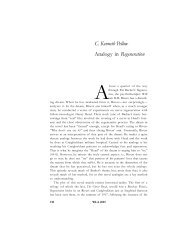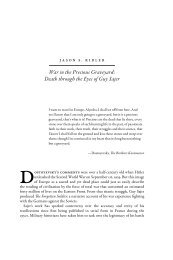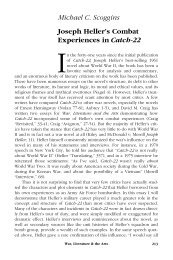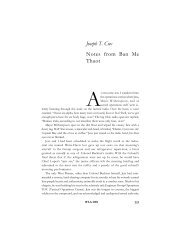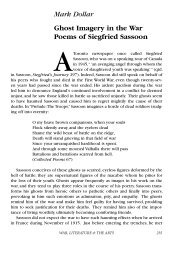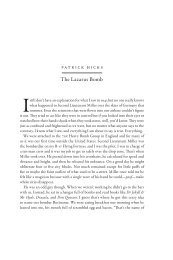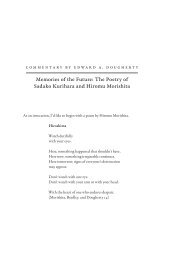Outside the Reign of Logic, Outside the Reach of God: Hester Panim ...
Outside the Reign of Logic, Outside the Reach of God: Hester Panim ...
Outside the Reign of Logic, Outside the Reach of God: Hester Panim ...
Create successful ePaper yourself
Turn your PDF publications into a flip-book with our unique Google optimized e-Paper software.
K I M B E R L Y S O C H A<br />
<strong>Outside</strong> <strong>the</strong> <strong>Reign</strong> <strong>of</strong> <strong>Logic</strong>, <strong>Outside</strong> <strong>the</strong> <strong>Reach</strong> <strong>of</strong> <strong>God</strong>:<br />
<strong>Hester</strong> <strong>Panim</strong> in <strong>the</strong> Surreal Art <strong>of</strong><br />
Paul Celan and Samuel Bak<br />
A<br />
rudimentary but <strong>of</strong>ten used definition <strong>of</strong> <strong>the</strong> “surreal” refers to true<br />
events that appear fantastic and dreamlike. History books are on <strong>the</strong><br />
o<strong>the</strong>r side <strong>of</strong> <strong>the</strong> spectrum, as <strong>the</strong>y purport to detail only <strong>the</strong> facts, facts<br />
which are real simply because <strong>the</strong>y are published as history. Occasionally, however,<br />
<strong>the</strong> real is so incredible that even factual accounts <strong>of</strong> it cannot help but lapse into<br />
depictions <strong>of</strong> <strong>the</strong> surreal. The events <strong>of</strong> <strong>the</strong> Holocaust mark an historical event so<br />
terrible that descriptions <strong>of</strong> it, even in factual accounts, become surreal because <strong>the</strong>y<br />
read like tales <strong>of</strong> horror. For example, a seemingly technical historical statistic—six<br />
million Jews were victims <strong>of</strong> genocide during WWII—is so shocking that history<br />
becomes a landscape <strong>of</strong> nightmare. This landscape is replete with unanswered and<br />
likely unanswerable philosophical and <strong>the</strong>ological dilemmas, <strong>the</strong> most common<br />
being: Where was <strong>God</strong> during <strong>the</strong> Holocaust?<br />
Post-Holocaust artists have attempted to depict this nightmare landscape and<br />
address this question through various media. Two artists in particular, poet Paul<br />
Celan and visual artist Samuel Bak, both Holocaust survivors, have used aspects<br />
<strong>of</strong> Surrealism to represent <strong>the</strong> nightmares <strong>of</strong> WWII. Louis Aragon, a founder<br />
<strong>of</strong> <strong>the</strong> surrealist movement, asserted, “‘Reality […] is <strong>the</strong> apparent absence <strong>of</strong><br />
contradiction. The marvelous is <strong>the</strong> eruption <strong>of</strong> contradiction within <strong>the</strong> real.’” 1 In<br />
Adam and Eve from Bak’s In a Different Light series and Celan’s poem “Tenebrae,” 2
classical elements <strong>of</strong> this surrealist sense <strong>of</strong> contradiction are used to depict <strong>the</strong><br />
Jewish concept <strong>of</strong> <strong>Hester</strong> <strong>Panim</strong> as an answer to questions about <strong>God</strong> and <strong>the</strong><br />
Holocaust. As defined by <strong>the</strong> Shoah Resource Center, <strong>Hester</strong> <strong>Panim</strong> refers to<br />
“<strong>God</strong>’s hiddenness. Some believe that <strong>God</strong> ‘hides’ Himself in order to tolerate sin<br />
in <strong>the</strong> world, and along <strong>the</strong> way people are hurt by that sin. O<strong>the</strong>rs assert that <strong>the</strong>re<br />
is no explanation for <strong>God</strong>’s hiding.” 3 This type <strong>of</strong> absence <strong>the</strong>ology can take many<br />
forms, as <strong>the</strong>re “are a variety <strong>of</strong> notions about <strong>the</strong> hiddenness <strong>of</strong> <strong>God</strong>, <strong>the</strong> absence <strong>of</strong><br />
<strong>God</strong>, <strong>the</strong> silence <strong>of</strong> <strong>God</strong>, and <strong>the</strong> eclipse <strong>of</strong> <strong>God</strong>.” 4 <strong>Hester</strong> <strong>Panim</strong> has a long history<br />
that is evidenced in <strong>the</strong> Old Testament books <strong>of</strong> Job and Es<strong>the</strong>r, and <strong>the</strong> questions<br />
<strong>of</strong> <strong>God</strong>’s absence that arise in those books are evident in <strong>the</strong> vistas that Bak and<br />
Celan create. Both depict an absent <strong>God</strong> and/or a fading <strong>God</strong> who has chosen<br />
to hide from <strong>the</strong> intolerable acts <strong>of</strong> Adolph Hitler’s “Final Solution.” Indeed, <strong>the</strong><br />
very act <strong>of</strong> attempting to depict a <strong>God</strong> who is not <strong>the</strong>re is steeped in incongruity.<br />
Thus, <strong>the</strong> works explored below speak to and for one ano<strong>the</strong>r; <strong>the</strong> images and ideas<br />
that Celan metaphorically paints in “Tenebrae,” Bak literally paints in Adam and<br />
Eve. The images and words contained <strong>the</strong>rein <strong>of</strong>fer avenues <strong>of</strong> emotional release for<br />
those burdened by <strong>the</strong> unanswerable queries that inevitably follow <strong>the</strong> tragedy <strong>of</strong><br />
war.<br />
Surrealism is a complex and esoteric artistic, literary and philosophical<br />
movement founded in France as a reaction to WWI carnage. The surrealists<br />
constituted <strong>the</strong> front lines <strong>of</strong> a subversive cultural shift that attempted to root<br />
out <strong>the</strong> principles that led to <strong>the</strong> 37,466,904 casualties <strong>of</strong> <strong>the</strong> so-called “War to<br />
End All Wars.” 5 The surrealistic elements <strong>of</strong> Bak’s and Celan’s work analyzed<br />
below are purposely less complex, focusing primarily on <strong>the</strong> contradictory images<br />
and psychological “gardening”—as in rooting through <strong>the</strong> darkest reaches <strong>of</strong> <strong>the</strong><br />
psyche—that naturally arise when one tries to represent living horrors. And this<br />
is a representation that has given up on <strong>the</strong> logic and ration that grounds Western<br />
philosophical traditions. There is no place more ruled by chaos and <strong>the</strong> irrational<br />
than <strong>the</strong> dreamscapes <strong>of</strong> <strong>the</strong> human mind. Thus, prompted by Sigmund Freud’s<br />
work on <strong>the</strong> subconscious, André Breton stated <strong>the</strong> following in his 1924 Manifesto<br />
<strong>of</strong> Surrealism:<br />
We are still living under <strong>the</strong> reign <strong>of</strong> logic […] But in this day and age<br />
logical methods are applicable only to solving problems <strong>of</strong> secondary<br />
interest […] Under <strong>the</strong> pretense <strong>of</strong> civilization and progress, we have<br />
managed to banish from <strong>the</strong> mind everything that may rightly or wrongly<br />
x War, Literature & <strong>the</strong> Arts
e termed superstition, or fancy; forbidden is any kind <strong>of</strong> search for truth<br />
which is not in conformance with accepted practices. 6<br />
However, <strong>the</strong> surrealists did not allow <strong>the</strong>ir philosophy, <strong>the</strong>ir interest in “fancy”<br />
and <strong>the</strong> “forbidden,” to slip into instances <strong>of</strong> mere nihilistic buffoonery. In<br />
contrast, <strong>the</strong>y asserted that <strong>the</strong> real was to be found within <strong>the</strong>se peripheral worlds:<br />
“Surrealism is not flight into <strong>the</strong> unreal or into dream, but an attempt to penetrate<br />
what has more reality than <strong>the</strong> logical and objective universe.” 7 Are Bak’s and<br />
Celan’s images fantastic, dreamlike, and unreal? Yes, but that does not make <strong>the</strong><br />
worlds <strong>the</strong>y create any less au<strong>the</strong>ntic—perhaps it makes <strong>the</strong>m more so. James E.<br />
Young quotes Holocaust scholar Robert Scholes as asserting that “‘it is because<br />
reality [itself] cannot be recorded that realism is dead […] We do not imitate <strong>the</strong><br />
world, we construct versions <strong>of</strong> it.” 8 Bak and Celan are students <strong>of</strong> this perspective,<br />
and <strong>the</strong>y use “fancy” and <strong>the</strong> “forbidden” to depict <strong>the</strong> completely illogical events<br />
<strong>of</strong> WWII. They have created art that expresses <strong>the</strong> search for <strong>God</strong> in <strong>the</strong> worlds<br />
<strong>the</strong>y have constructed. Their art is not reality per se, but it is <strong>the</strong>ir constructions<br />
<strong>of</strong> <strong>the</strong> truths <strong>the</strong>y came to know, truths so terrible that depictions <strong>of</strong> it fall outside<br />
“<strong>the</strong> reign <strong>of</strong> logic” and far from <strong>the</strong> embrace <strong>of</strong> <strong>God</strong>.<br />
Celan and Bak: Holocaust Survivors<br />
Both Paul Celan (1920-1970) and Samuel Bak (b. 1933) survived <strong>the</strong> atrocities <strong>of</strong><br />
<strong>the</strong> Holocaust. However, <strong>the</strong>ir physical survivals belie <strong>the</strong> continued emotional<br />
imprisonment that is evident in <strong>the</strong>ir complexly stunning artistic creations. As<br />
Lawrence Langer eloquently states, “[T]he artist has few illusions about <strong>the</strong> ease <strong>of</strong><br />
renewal. The task <strong>of</strong> escaping <strong>the</strong> weight <strong>of</strong> memory imposes a nearly insuperable<br />
burden on <strong>the</strong> imagination seeking to create pr<strong>of</strong>use options for <strong>the</strong> future.” 9 The<br />
violent acts that Celan and Bak witnessed were never fully purged from <strong>the</strong>ir<br />
minds, and memories <strong>of</strong> <strong>the</strong>se horrors serve as <strong>the</strong> impetus for much <strong>of</strong> <strong>the</strong>ir artistic<br />
output. Surrealism, which attempts to plumb and purify <strong>the</strong> psyche, provides a<br />
logical avenue through which to attempt such psychological catharsis. At 22, Celan,<br />
a Romanian Jew, was moved from a ghetto to a labor camp where his parents would<br />
die. While “freed” from <strong>the</strong> Holocaust in 1944, Celan’s attempts to grapple with<br />
his past ended in 1970, when he killed himself by drowning in <strong>the</strong> Seine River.<br />
Bak’s family was moved to <strong>the</strong> Vilna, Poland ghetto in 1940. His fa<strong>the</strong>r was shot<br />
just before Vilna’s 1944 liberation. He and his mo<strong>the</strong>r were two <strong>of</strong> <strong>the</strong> few from<br />
Vilna who had survived by war’s end.<br />
An International Journal <strong>of</strong> <strong>the</strong> Humanities x
Bak’s 2001 autobiography Painted in Words: A Memoir clearly demonstrates <strong>the</strong><br />
ways in which events <strong>of</strong> ghetto and camp life mirror <strong>the</strong> use <strong>of</strong> <strong>the</strong> extraordinary<br />
and paradoxical images that dominate surrealist art. Bak writes <strong>of</strong> an “Exhibition<br />
<strong>of</strong> Art” that took place in <strong>the</strong> ghetto: “A waiting room for <strong>the</strong> horrors <strong>of</strong> <strong>the</strong><br />
death camps seems an unlikely setting for something meant to liberate <strong>the</strong> spirit<br />
and bring joy. Yet it is not an unusual conjunction, as we know from many books<br />
about <strong>the</strong> Holocaust.” 10 As shown in <strong>the</strong> following excerpt, Bak’s autobiography<br />
abounds with fur<strong>the</strong>r surreal images “painted in words,” just as <strong>the</strong> title <strong>of</strong> his<br />
memoir promises. On a train from Lodz to Berlin after <strong>the</strong> war, <strong>the</strong> artist reports<br />
<strong>the</strong> following:<br />
The first impression is <strong>of</strong> total blackness, and <strong>the</strong>n gradually contours<br />
start to emerge. Strange animal-like sounds and bizarre smells filter into<br />
our small space. We are in a sort <strong>of</strong> anteroom that gives access to <strong>the</strong> rest<br />
<strong>of</strong> <strong>the</strong> car. Two or three Red Army men in heavy coats, reeking <strong>of</strong> vomit<br />
and alcohol, are spread on <strong>the</strong> floor and snore. I hear distant voices and<br />
see some light filtering through <strong>the</strong> side <strong>of</strong> a closed door. 11<br />
These examples, rife with multi-sensory images that slowly arise from <strong>the</strong> train’s<br />
moving darkness, maintain a dreamlike/nightmare quality, showing <strong>the</strong> ways<br />
in which <strong>the</strong> Holocaust essentially served as fertile ground from which surreal<br />
gardens <strong>of</strong> remembrance could grow.<br />
Celan and Bak have long been seen as surrealistic, though not necessarily as<br />
surrealists proper. 12 In her 1993 study <strong>of</strong> Celan, Clarise Samuels asserts that <strong>the</strong><br />
poet’s surrealist style in depicting Holocaust <strong>the</strong>mes “has already been noted<br />
and analyzed by a number <strong>of</strong> scholars. As early as 1954, Hans Egon Holthusen<br />
commented on <strong>the</strong> French surrealists’ influence on Celan’s lyrics.” 13 Similarly,<br />
while Bak was influenced by Cubism during his early career, his interest in <strong>the</strong><br />
surreal was honed during <strong>the</strong> late 1960s/ early 1970s. Pam Chadick notes this<br />
shift by stating that in “<strong>the</strong> 1960s he discarded abstraction for a style that required<br />
more realistic rendering, but incorporated images that verged on <strong>the</strong> surreal […]<br />
Bak does interesting things with his motifs and symbols […] by forcing surprising<br />
relationships between <strong>the</strong> symbol and <strong>the</strong> world that he creates in <strong>the</strong>se paintings.” 14<br />
Although Celan and Bak are not completely aligned with <strong>the</strong> historical Surrealist<br />
movement, both artists certainly used <strong>the</strong> surrealist tropes <strong>of</strong> contradiction and<br />
spectacular imagery to question both <strong>the</strong> horrors <strong>of</strong> war and <strong>God</strong>’s responsibility<br />
for <strong>the</strong>m and/or absence from <strong>the</strong>m. This is an act very much in keeping with <strong>the</strong><br />
x War, Literature & <strong>the</strong> Arts
spirit <strong>of</strong> Surrealism, a movement that eschewed both <strong>the</strong> concept <strong>of</strong> a higher power<br />
and <strong>the</strong> primacy <strong>of</strong> logic within Western discourse.<br />
Celan and <strong>the</strong> Absence <strong>of</strong> <strong>God</strong> in “Tenebrae”<br />
Paradoxically, but true to form, <strong>the</strong> surrealists declared that traditional modes <strong>of</strong><br />
artistic production, both in writing and art, were defunct. This contradiction, some<br />
would say hypocrisy—<strong>of</strong> a writer writing that writing is dead—was not lost on <strong>the</strong><br />
surrealists’ contemporary critics. But however much <strong>the</strong> surrealists believed that art<br />
no longer existed, <strong>the</strong> fact is that <strong>the</strong>y did continue to write, and most would agree<br />
that <strong>the</strong>y did so with quite a degree <strong>of</strong> finesse. In reality, such declarations were more<br />
a way <strong>of</strong> ensuring that art would become fused with <strong>the</strong> happenings <strong>of</strong> everyday life.<br />
Georges Hugnet asserted that poetry had slipped from <strong>the</strong> page to “‘to <strong>the</strong> center <strong>of</strong><br />
life. It is no longer an art, a spiritual state, but life, spirit.’” 15 Paul Celan’s “Tenebrae”<br />
relies on surreal contradiction to make meaning and to create spirit both in <strong>the</strong><br />
communal sense and with <strong>the</strong> faint expectation <strong>of</strong> renewal. In “Tenebrae,” Celan, a<br />
Jewish poet, 16 appears to be addressing a Christian “Lord.” David Wolpe notes that<br />
“metaphorical language [poetry] is intrinsically suspect when it comes to <strong>the</strong>ology”<br />
because it signifies an attempt to depict something beyond <strong>the</strong> capability <strong>of</strong> humans<br />
to comprehend, something that “transcends” language. 17 However, he concludes<br />
that although metaphor is inadequate, it is <strong>the</strong> primary communicative option that<br />
we have as human beings, explaining that “as we cannot speak without recourse to<br />
metaphor, we cannot <strong>the</strong>ologize without it […] <strong>the</strong> metaphor <strong>of</strong> eclipse is part <strong>of</strong><br />
<strong>the</strong> congeries <strong>of</strong> images about <strong>God</strong>’s silence, hiddenness and inactivity which run<br />
through Jewish tradition and have become exquisitely apposite in <strong>the</strong> wake <strong>of</strong> <strong>the</strong><br />
Holocaust.” 18 Celan, consequently, appropriates Christian metaphorical language<br />
in addressing <strong>the</strong> concept <strong>of</strong> <strong>Hester</strong> <strong>Panim</strong> and in bringing this language to <strong>the</strong><br />
“‘center <strong>of</strong> life.’” Since <strong>the</strong> <strong>God</strong> <strong>of</strong> <strong>the</strong> covenant has abandoned His people, <strong>the</strong><br />
speaker’s only recourse is to address ano<strong>the</strong>r <strong>God</strong>. In essence, Celan “mobilizes <strong>the</strong><br />
trope <strong>of</strong> humanity’s separation from <strong>the</strong> messiah” through <strong>the</strong> language <strong>of</strong> poetry. 19<br />
Conversely, <strong>the</strong>re is also <strong>the</strong> conflicting sense that <strong>the</strong> <strong>God</strong> <strong>of</strong> <strong>the</strong> covenant still<br />
exists somewhere, as demonstrated by <strong>the</strong> fury directed at that entity. Therefore, a<br />
simple Deistic <strong>the</strong>ological perspective will not work here. Ra<strong>the</strong>r, <strong>the</strong> speaker, and<br />
speakers, <strong>of</strong> this poem find affinity with <strong>the</strong>ir bro<strong>the</strong>r Jesus Christ, ano<strong>the</strong>r Jewish<br />
man who was tortured, sacrificed, and seemingly abandoned by his Fa<strong>the</strong>r.<br />
The very title <strong>of</strong> this poem refers to <strong>the</strong> Christian Tenebrae service that takes place<br />
during <strong>the</strong> Holy Week before Easter. Tenebrae—which in Latin means “shadows”—<br />
attempts to reconstruct <strong>the</strong> emotive elements <strong>of</strong> <strong>the</strong> passion and crucifixion <strong>of</strong><br />
An International Journal <strong>of</strong> <strong>the</strong> Humanities x
Jesus Christ. In Celan’s Tenebrae service, <strong>the</strong> death <strong>of</strong> Christ is compared to <strong>the</strong><br />
deaths <strong>of</strong> Jews as <strong>the</strong>y send out an alert to <strong>God</strong>: “We are near, Lord,/ near and at<br />
hand” (lines 1-2). 20 To be near to <strong>God</strong> is to be close to death or deceased already.<br />
The second stanza <strong>of</strong> <strong>the</strong> poem juxtaposes <strong>the</strong> events <strong>of</strong> <strong>the</strong> Holocaust to Christ’s<br />
passion, while also alluding to <strong>the</strong> murder <strong>of</strong> Jews in gas chambers:<br />
Handled already, Lord,<br />
clawed and clawing as though<br />
<strong>the</strong> body <strong>of</strong> each <strong>of</strong> us were<br />
your body, Lord. (lines 3-6)<br />
Although <strong>the</strong> reference is subtle, <strong>the</strong> Lord here is quite possibly a Christian <strong>God</strong>, as<br />
it was his son Jesus Christ who was made into flesh/ “body” and brutally “handled”<br />
by <strong>the</strong> Romans. In Paul Celan: Poet, Survivor, Jew, John Felstiner notes that Celan<br />
adapted <strong>the</strong> fourth line <strong>of</strong> this poem from “Gerald Reitlinger’s ground-breaking<br />
study The Final Solution” in which, “at <strong>the</strong> end <strong>of</strong> an already horrifying paragraph,<br />
a cluster <strong>of</strong> Jews pressing against <strong>the</strong> gas chamber door, suffocating, is described as<br />
‘even in death clawed into each o<strong>the</strong>r.’” 21 The speaker 22 expresses rage that is evident<br />
in his warning to <strong>God</strong> that <strong>the</strong> suffering are “clawing” <strong>the</strong>ir way to He who allowed<br />
<strong>the</strong>m to be so brutally “handled” by <strong>the</strong> Nazis.<br />
The third stanza <strong>of</strong> “Tenebrae” completely circumvents <strong>the</strong> traditional landscape<br />
<strong>of</strong> religious worship, <strong>the</strong>reby exemplifying how Celan uses contradiction to direct<br />
fury toward as well as deny <strong>God</strong>. He revisions pious souls at prayer as angry souls<br />
demanding that <strong>the</strong>ir negated deity pray to <strong>the</strong>m: “Pray, Lord,/ pray to us,/ we<br />
are near” (lines 7-9, emphasis added). This stanza was controversial from <strong>the</strong><br />
start, causing Celan’s Catholic friend Otto Pöggeler to advise that he remove <strong>the</strong><br />
“‘sacrilegious’” line quoted above. 23 In fact, Celan did initially take Pöggeler’s advice,<br />
but eventually decided to restore it before final publication. The implication, again,<br />
is that <strong>the</strong> Jews are “clawing” <strong>the</strong>ir way to <strong>the</strong> <strong>God</strong> who has abandoned <strong>the</strong>m. <strong>God</strong>,<br />
<strong>the</strong>refore, is advised to pray to <strong>the</strong>m, perhaps for forgiveness. In “Washing <strong>of</strong> <strong>the</strong><br />
Word, Washing <strong>of</strong> <strong>the</strong> World,” Beth Hawkins aptly notes that what “emerges in <strong>the</strong><br />
space <strong>of</strong> destruction [<strong>the</strong> Holocaust] is a conditional covenant that paradoxically<br />
renders <strong>the</strong> previous conditions—i.e. that <strong>the</strong> keeping <strong>of</strong> <strong>the</strong> Torah necessitates<br />
protection—null and void.” 24 For a Jew during and after <strong>the</strong> Holocaust, <strong>God</strong>’s<br />
negation <strong>of</strong> <strong>the</strong> Biblical covenant would seem a likely supposition. In return, <strong>God</strong><br />
is negated.<br />
x War, Literature & <strong>the</strong> Arts
The next two stanzas refer back to stanza two, in which elements <strong>of</strong> daily life in<br />
<strong>the</strong> camps are depicted amidst a hectic landscape:<br />
Wind awry we went <strong>the</strong>re,<br />
went <strong>the</strong>re to bend<br />
over hollow and ditch.<br />
To be watered we went <strong>the</strong>re, Lord. (lines 10-13)<br />
The image here evokes <strong>the</strong> harsh conditions under which one was expected to<br />
work in <strong>the</strong> labor camps. In fact, <strong>the</strong> Romanian camp in which Celan worked was<br />
eventually closed due to extremely bad wea<strong>the</strong>r conditions. The exact details <strong>of</strong> <strong>the</strong><br />
poet’s time in <strong>the</strong> forced-labor camps are sketchy. Felstiner notes <strong>the</strong> following:<br />
“‘Shoveling!’ is what [Celan] would say when asked […] what work he did [in <strong>the</strong><br />
camp].” 25 In <strong>the</strong> stanzas above, <strong>the</strong> shoveling has already been done. Jews were<br />
forced to shovel to create a final (un)resting place for <strong>the</strong> bodies <strong>of</strong> <strong>the</strong>ir murdered<br />
brethren. The speaker and his companions, <strong>the</strong> “we,” look down into <strong>the</strong> depths <strong>of</strong><br />
<strong>the</strong> earth waiting to be “watered” like flowers—a reference to being drenched with<br />
<strong>the</strong>ir own blood in front <strong>of</strong> a Nazi firing squad. As Samuels writes, Celan <strong>of</strong>ten<br />
used <strong>the</strong> flower trope as part <strong>of</strong> his surrealist repertoire:<br />
The flower motif reminiscent <strong>of</strong> spring and life is combined with […]<br />
images <strong>of</strong> destruction, death, and <strong>the</strong> Holocaust. This contradiction is<br />
a reminder <strong>of</strong> <strong>the</strong> fact that <strong>the</strong> German death camps <strong>of</strong> <strong>the</strong> Holocaust<br />
<strong>of</strong>ten possessed bizarre contrasts with nature and civilization that<br />
included garden paths and music within <strong>the</strong> camps, as well as <strong>the</strong> camps’<br />
surrounding countryside. This bizarre incongruity, which defied words,<br />
existed as an aura, palpably present yet always intangible. 26<br />
This seemingly inherent contradictory aspect <strong>of</strong> life in Nazi camps, as ably noted<br />
by Samuels, is confirmed by Bak’s memories <strong>of</strong> WWII (see passages quoted above<br />
from his memoir), again confirming that <strong>the</strong> reality <strong>of</strong> <strong>the</strong> Holocaust is most<br />
suitably reconstructed through a surreal filter due to <strong>the</strong> seemingly incompatible<br />
elements <strong>of</strong> life during <strong>the</strong> war.<br />
Celan’s surreal vista is fur<strong>the</strong>r darkened, or reddened, as <strong>the</strong> speakers, <strong>the</strong> “we” <strong>of</strong><br />
<strong>the</strong> poem, are watered with blood: “It was blood, it was/ what you shed, Lord” (lines<br />
14-15). Jews, persecuted because <strong>of</strong> religious beliefs, are found bathing in <strong>the</strong> blood<br />
<strong>of</strong> a Christian <strong>God</strong> who made His son flesh with <strong>the</strong> knowledge that he would <strong>the</strong>n<br />
An International Journal <strong>of</strong> <strong>the</strong> Humanities x
e tortured and sacrificed. Although <strong>the</strong> image itself seems illogical, this is a logical<br />
comparison made by a speaker, or speakers, attempting to comprehend his people’s<br />
own incomprehensible torture and sacrifice. He continues with a description <strong>of</strong> <strong>the</strong><br />
blood that “gleamed”:<br />
It cast your image into our eyes, Lord.<br />
Our eyes and our mouths are so open and empty, Lord.<br />
We have drunk, Lord.<br />
The blood and <strong>the</strong> image that was in <strong>the</strong> blood, Lord. (lines 17-20)<br />
In this stanza, “Tenebrae” becomes a prayer to an absent Judaic <strong>God</strong> through<br />
its repeated call to a Christian Lord who shed his own blood for <strong>the</strong> salvation<br />
<strong>of</strong> humankind, an event reenacted in countless Christian ceremonial masses. In<br />
fact, Celan asserts that <strong>the</strong> Jews are Jesus Christ (a somewhat logical comparison<br />
since Christ was himself Jewish). There is no differentiation between <strong>the</strong> ultimate<br />
iconic image <strong>of</strong> self-sacrifice, Jesus Christ, and <strong>the</strong> victims <strong>of</strong> <strong>the</strong> Holocaust. Christ<br />
resides in <strong>the</strong> lifeless eyes <strong>of</strong> <strong>the</strong> massacred Jews; <strong>the</strong>y swallow him, drink him,<br />
both his literal blood, via <strong>the</strong> sacrament <strong>of</strong> communion, and <strong>the</strong> image <strong>of</strong> him<br />
crucified. This use <strong>of</strong> dogmatic contradiction is not unique to Celan. For example,<br />
in 1938, Jewish artist Marc Chagall painted The White Crucifixion, depicting<br />
Christ amidst “a pogrom” in which “some cottages have been turned over, <strong>the</strong>ir<br />
possessions scattered and owners killed … [and] Christ, [depicted on <strong>the</strong> cross,<br />
wears] a Jewish prayer-shawl.” 27 The historical use <strong>of</strong> Christian iconography by<br />
Jewish artists is noted by Felstiner and expounded upon in relation to <strong>the</strong> New<br />
Testament when Christ asks during his final hours: “‘Eli, Eli, Lama Sabachthani’<br />
that is, ‘My <strong>God</strong>, My <strong>God</strong>, why have you forsaken me?” 28 This question, <strong>of</strong> course,<br />
is met with <strong>the</strong> sourness <strong>of</strong> a sponge soaked with vinegar. Like Christ, <strong>the</strong> Jews cry<br />
out to a seemingly disinterested <strong>God</strong>; in response, <strong>the</strong>y are only fed more bitterness.<br />
This poem, <strong>of</strong>fered to readers as a bizarre Tenebrae service, ends as it began,<br />
with a collective “we” addressing <strong>God</strong> in an unexpected manner: “Pray, Lord./<br />
We are near” (lines 21-22). The speaker makes a final demand <strong>of</strong> <strong>the</strong> Lord who has<br />
abandoned <strong>the</strong> Jews in <strong>the</strong> horrid landscape that unfolds in <strong>the</strong> second, fourth, and<br />
eighth stanzas. In between <strong>the</strong>se stanzas <strong>God</strong> is beseeched to notice <strong>the</strong>ir suffering,<br />
but <strong>the</strong>y, like <strong>the</strong>ir Jewish bro<strong>the</strong>r Christ, are left forsaken. Whe<strong>the</strong>r or not <strong>God</strong> is<br />
hidden, eclipsed, or disinterested, his people are approaching him. They have been<br />
“handled” and “clawed,” and <strong>the</strong>y know <strong>the</strong>y will die. Some are already dead. When<br />
alive, <strong>the</strong>y were always already near death.<br />
x War, Literature & <strong>the</strong> Arts
Bak and <strong>the</strong> Absence <strong>of</strong> <strong>God</strong> in Adam and Eve<br />
Although one must be careful when attempting to understand <strong>the</strong> artist through<br />
his/her art, Samuel Bak’s reference to himself as a “‘<strong>God</strong>-fearing a<strong>the</strong>ist’” is<br />
pertinent here. 29 The phrase epitomizes one <strong>of</strong> <strong>the</strong> main components <strong>of</strong> this study:<br />
<strong>Hester</strong> <strong>Panim</strong> via <strong>the</strong> contradictory depiction <strong>of</strong> an absent supreme deity. Scott<br />
Ruescher’s review <strong>of</strong> Bak’s show, In a Different Light: Genesis in <strong>the</strong> Art <strong>of</strong> Samuel<br />
Bak, summarizes <strong>the</strong> series as a whole, while capturing <strong>the</strong> artist’s use <strong>of</strong> Surrealism:<br />
[I]n painting after painting, [Bak uses] appropriated depictions <strong>of</strong> Adam<br />
himself, in <strong>the</strong> unmistakable guise <strong>of</strong> a hunted-down European Jew […]<br />
In Bak’s bizarre paintings, [he] strip[s] down Michelangelo’s sensual<br />
settings <strong>of</strong> <strong>the</strong> Genesis stories and dress[es] <strong>the</strong>m back up in ghastlier garb<br />
[…] Adam, a pallid, stubble-faced, burr-headed, gaunt, and hopelessly<br />
impassive figure, no longer relishes a languid nonchalance, and no longer<br />
counts on an imminent touch from <strong>the</strong> warm hand <strong>of</strong> <strong>God</strong> […] Bak makes<br />
liberal use <strong>of</strong> surrealist symbolism to drive home his never-exactly-subtle<br />
visionary point about <strong>the</strong> Holocaust as pro<strong>of</strong> <strong>of</strong> humanity’s estrangement<br />
from <strong>the</strong> divine. 30<br />
In Adam and Eve, 31 part <strong>of</strong> this series, Bak, like Celan before him, works with<br />
religious iconography to depict <strong>the</strong> effects <strong>of</strong> <strong>the</strong> Holocaust on both <strong>the</strong> human<br />
psyche and <strong>the</strong> Jewish relationship with <strong>God</strong>. Indeed, an “estrangement” bordering<br />
on complete abandonment dominates <strong>the</strong> austere landscape that Bak creates.<br />
Ferdinand Alquié, philosopher <strong>of</strong> <strong>the</strong> surreal, affirms that in “Surrealism […] <strong>the</strong><br />
imaginary comes ceaselessly to break <strong>the</strong> framework <strong>of</strong> <strong>the</strong> given, to surpass it,” but<br />
that <strong>the</strong> end results are always, inevitably, compared to <strong>the</strong> real. 32 Bak breaks <strong>the</strong><br />
frames <strong>of</strong> reality (“<strong>the</strong> given”) by depicting conditions <strong>of</strong> a brutal reality amidst a<br />
conflux <strong>of</strong> extraordinary and unsettling images. Thus, his Adam and Eve serves as<br />
a striking counterpart to Celan’s “Tenebrae.”<br />
While <strong>the</strong> creation <strong>of</strong> Adam is an aspect <strong>of</strong> both Judaic and Christian dogma,<br />
Bak, like Celan with <strong>the</strong> Tenebrae service, borrows from Christian/Western<br />
iconography; in this case, he utilizes Michelangelo Buonarroti’s The Creation <strong>of</strong><br />
Adam, from <strong>the</strong> Sistine Chapel in Vatican City. In Using and Abusing <strong>the</strong> Holocaust,<br />
Langer explains that Michelangelo’s painting “is charged with tension between<br />
human expectation and divine wish. The focal point is <strong>the</strong> narrow space dividing<br />
<strong>God</strong>’s resolute finger from Adam’s languid hand, awaiting <strong>the</strong> spark <strong>of</strong> vitality that<br />
will give life.” 33 Eve, meanwhile, is securely wrapped in <strong>God</strong>’s arm amidst a chorus<br />
An International Journal <strong>of</strong> <strong>the</strong> Humanities x
<strong>of</strong> fleshy cherubim. Adam and Eve is indicative <strong>of</strong> Bak’s distinctive iconography<br />
which “draws on strong and well-known European pictorial traditions” in which<br />
“we find <strong>the</strong> real refigured as <strong>the</strong> surreal […] suffused with <strong>the</strong> unmistakable nightmarish<br />
smoldering <strong>of</strong> <strong>the</strong> historical moment after Auschwitz.” 34 Bak’s use <strong>of</strong> easily<br />
recognizable icons is quite brilliant on two levels. First, it draws <strong>the</strong> viewer in<br />
because most are already familiar with Michelangelo’s classic Renaissance image.<br />
Next, it reworks <strong>the</strong> image to expose <strong>the</strong> lie <strong>of</strong> protection promised by <strong>the</strong> covenant,<br />
<strong>the</strong>reby exposing <strong>the</strong> viewer to <strong>the</strong> (sur)reality <strong>of</strong> iniquity let loose on earth.<br />
The very act <strong>of</strong> appropriating a Christian image <strong>of</strong> <strong>God</strong> announces Bak’s<br />
fracturing <strong>of</strong> traditional Judaic practice. Unlike Christianity, Judaism does not <strong>of</strong>fer<br />
an abundant catalogue <strong>of</strong> divine images. The absence <strong>of</strong> imagery in Judaic tradition<br />
is partly due to interpretations <strong>of</strong> <strong>the</strong> Second Commandment, which warns against<br />
idolatry. In “‘Make yourself no graven image’: The Second Commandment and<br />
Judaism,” Carl S. Ehrlich expounds upon <strong>the</strong> Jewish prohibition against creating<br />
images <strong>of</strong> <strong>God</strong>—although he does note ruptures within this “aniconic” tradition. 35<br />
He states, “[Historically, in Christian Europe] <strong>the</strong> Jewish community interpreted<br />
<strong>the</strong> Second Commandment in reaction to <strong>the</strong> iconography <strong>of</strong> <strong>the</strong> Church,<br />
which in Jewish eyes contained more than a trace <strong>of</strong> idolatry.” 36 In contrast, Bak<br />
paradoxically uses <strong>the</strong>se very Christian idols to depict an abandoned Jewish people.<br />
In appropriate surreal (paradoxical) fashion, however, Bak depicts <strong>God</strong> without<br />
actually depicting him at all.<br />
Michelangelo’s Christian/Renaissance representation <strong>of</strong> <strong>God</strong> as dynamic being,<br />
giver <strong>of</strong> life, and all-powerful entity is nothing less than inert in Bak’s version. A<br />
juxtaposition <strong>of</strong> <strong>the</strong>se two paintings is remarkable. The robust and lively Adam<br />
and Eve from Creation are replaced with pale, emaciated, sorrowful figures who<br />
are no longer protected by <strong>God</strong> (again, strikingly similar to <strong>the</strong> speakers in Celan’s<br />
poem). Bak’s Adam appears near death as he points and looks at something beyond<br />
<strong>the</strong> images on <strong>the</strong> canvas. Eve is presented above, lethargically pointing at Adam<br />
through a break in <strong>the</strong> wall. Langer makes <strong>the</strong> astute observation “that those<br />
familiar with Bak’s earlier work will instantly recognize […] <strong>the</strong> wall from a chamber<br />
<strong>of</strong> death.” 37 In <strong>the</strong> distance, crematoria are actively puffing out smoke—from <strong>the</strong><br />
remains <strong>of</strong> murdered Jews—that combines effortlessly with <strong>the</strong> threatening sky.<br />
Indeed, death permeates this entire nightmare landscape. The vivid, rich, and<br />
varied hues <strong>of</strong> Creation are replaced with <strong>the</strong> shades <strong>of</strong> red that drench Bak’s Adam<br />
and Eve. Just as Celan’s Jews are watered with blood in “Tenebrae,” so are Bak’s.<br />
Again, we return to <strong>the</strong> query that confounds historians, <strong>the</strong>ologians,<br />
philosophers, and survivors: Where was <strong>God</strong> during <strong>the</strong> Holocaust? In Adam and<br />
x War, Literature & <strong>the</strong> Arts
Eve, he is as good as gone, reduced to a mere outline, to a fading memory on <strong>the</strong> death<br />
chamber wall. The finger <strong>of</strong> vitality that first ignited humankind points not at man<br />
but, again, at something beyond <strong>the</strong> canvas. The two “divine” hands represented—<br />
<strong>the</strong> top one connected to <strong>the</strong> outline <strong>of</strong> <strong>God</strong>, <strong>the</strong> bottom one to a makeshift arm<br />
made out <strong>of</strong> wood—are wearing gloves. With His hands gloved/bound, <strong>God</strong> is<br />
not available to transfer <strong>the</strong> spark <strong>of</strong> life that galvanizes Michelangelo’s Creation.<br />
Indeed, <strong>the</strong> bottom hand is completely ineffective because it has been securely<br />
nailed to <strong>the</strong> death chamber wall—an image that Langer correlate’s with Christ’s<br />
crucifixion, <strong>the</strong>reby showing this painting’s fur<strong>the</strong>r affinity with “Tenebrae” and<br />
Chagall’s White Crucifixion. The grand incongruity, and one that secures Bak’s use<br />
<strong>of</strong> contradiction, is <strong>the</strong> implication that a supposedly all-powerful <strong>God</strong> is not able<br />
to revitalize his people.<br />
As observed in Celan’s poem, <strong>the</strong> use <strong>of</strong> unexpected and complex imagery results<br />
in a barrage <strong>of</strong> rational quandaries that form <strong>the</strong> basis <strong>of</strong> <strong>Hester</strong> <strong>Panim</strong>: Is <strong>God</strong><br />
absent? Eclipsed? Disinterested? Did he ever exist? The positioning <strong>of</strong> hands in<br />
Adam and Eve attempts to address <strong>the</strong>se questions. The “narrow space” between<br />
<strong>God</strong> and man in Michelangelo’s Creation has become a seemingly insurmountable<br />
chasm in Bak’s revision. Adam and Eve scarcely have <strong>the</strong> strength to lift <strong>the</strong>ir hands.<br />
To point at Adam, Eve must rest her small frame against <strong>the</strong> wall. In return, <strong>the</strong><br />
Adam she points at barely has <strong>the</strong> strength to gesture at something that remains<br />
unseen. In contrast, <strong>God</strong>’s hands are infused with <strong>the</strong> strength to point rigidly, but<br />
he points away from Adam and Eve, and <strong>the</strong> outline <strong>of</strong> his head shows that he also<br />
looks away from <strong>the</strong>m. The implication may be that <strong>God</strong>, indeed, does have <strong>the</strong><br />
strength to attend to his people. However, he chooses not to. If this is <strong>the</strong> case, <strong>the</strong>n<br />
perhaps <strong>the</strong> reds in this painting are not blood so much as representations <strong>of</strong> anger<br />
directed at a disinterested deity. With <strong>God</strong> absent, nonexistent, or disinterested,<br />
Adam and Eve are <strong>the</strong> only remaining “real” figures in Bak’s painting. However,<br />
<strong>the</strong>y find no solace in each o<strong>the</strong>r. Eve’s coquettish look in Michelangelo’s Creation<br />
is replaced with a downcast stare in Adam and Eve. Adam, meanwhile, appears too<br />
weak to lift his eyes up to his female counterpart. Abandoned by <strong>God</strong>, <strong>the</strong>y remain<br />
distant from each o<strong>the</strong>r. There is no divinity, and <strong>the</strong>re is no humanity. Their hands,<br />
those appendages that should connect human beings to each o<strong>the</strong>r through <strong>the</strong><br />
power <strong>of</strong> touch, are flaccid and unseen by <strong>the</strong>ir respective and prospective partners.<br />
Meanwhile, <strong>the</strong> “hand <strong>of</strong> <strong>God</strong> has lost its way.” 38 Adam and Eve are ultimately<br />
alone in this landscape, separated from <strong>God</strong>, possibly by <strong>God</strong>, and distant from<br />
each o<strong>the</strong>r.<br />
An International Journal <strong>of</strong> <strong>the</strong> Humanities x
The verdant sash which trail’s from <strong>God</strong>’s entourage in Creation is transformed<br />
into a white flag that leans against <strong>the</strong> death chamber wall, though its positioning<br />
is such that it appears to be in Adam’s hand. Does <strong>the</strong> flag symbolize that Adam has<br />
given up? Is he waving <strong>the</strong> proverbial white flag <strong>of</strong> surrender? Are he and Eve subtly<br />
whispering, “We cannot take any more! Cease fire, Lord!”? If, indeed, those cries<br />
whisper through this conflux <strong>of</strong> bizarre icons and post-Holocaust images, <strong>God</strong> has<br />
not heard <strong>the</strong>m. He is looking and pointing elsewhere. Indeed, He appears as if He<br />
will fly <strong>of</strong>f and away from a deserted people who remain mired in a chaotic land.<br />
Christ’s words in Mat<strong>the</strong>w 27 again resound: “‘My <strong>God</strong>, My <strong>God</strong>, why have you<br />
forsaken me?’”<br />
Conclusion: Depicting Absence<br />
Despite ongoing debates over whe<strong>the</strong>r or not it is appropriate to write <strong>of</strong> and depict<br />
<strong>the</strong> Holocaust, those re-imaginings continue to occur in writing and <strong>the</strong> visual arts<br />
(especially in film). Our continued fascination with <strong>the</strong> Holocaust shows a desire to<br />
understand both how and why such a tragedy occurred. There is an apparent human<br />
impulse to believe that with enough study, with enough rational investigation and<br />
knowledge, we can understand anything. The surrealists did not believe this, yet<br />
despite protests to <strong>the</strong> contrary, <strong>the</strong>y did not give up on using textual and visual<br />
artistry to grapple with tragedy and <strong>the</strong> unknown. The questions remain: How<br />
could <strong>the</strong> Germans let this happen? How could <strong>the</strong> world let this happen? How<br />
could <strong>God</strong> let this happen? Does <strong>God</strong> really exist? Is <strong>the</strong> Holocaust pro<strong>of</strong> that He<br />
doesn’t? The poetry <strong>of</strong> Celan and <strong>the</strong> art <strong>of</strong> Bak serve as ideal examples <strong>of</strong> how <strong>the</strong><br />
unspeakable and unseeable can powerfully become spoken and seen. To understand<br />
Celan’s poem is to understand Bak’s painting, and vice versa. In both cases, success<br />
<strong>of</strong> <strong>the</strong> artist lies in <strong>the</strong> dynamic representation <strong>of</strong> <strong>Hester</strong> <strong>Panim</strong> and <strong>the</strong> questioning<br />
<strong>of</strong> <strong>God</strong>. In <strong>the</strong>se cases, <strong>the</strong> answers are not joyful; ra<strong>the</strong>r, <strong>the</strong>y are woeful, violent,<br />
angry, and ba<strong>the</strong>d in blood—exactly like <strong>the</strong> Holocaust itself. In “Tenebrae”<br />
and Adam and Eve, readers and viewers meet <strong>the</strong> undead. In <strong>the</strong> former <strong>the</strong>y are<br />
“clawing” <strong>the</strong>ir way to <strong>God</strong> demanding answers, while in <strong>the</strong> latter <strong>the</strong>y are adrift<br />
in a chaotic morass from which <strong>God</strong> is ei<strong>the</strong>r fleeing or hopelessly absent. Aspects<br />
<strong>of</strong> Surrealism—<strong>the</strong> subconscious, contradiction, and <strong>the</strong> irrational—combined<br />
with an appropriation <strong>of</strong> Christian imagery, have provided a sieve through which<br />
<strong>the</strong>se artists can purge <strong>the</strong>ir unconscious minds to depict unconscionable acts and<br />
unexplained absences.<br />
Ideally, it is hope, forgiveness, and triumph <strong>of</strong> <strong>the</strong> human spirit that will be<br />
<strong>the</strong> ultimate outcomes <strong>of</strong> history’s past, present, and future atrocities. That is not<br />
x War, Literature & <strong>the</strong> Arts
<strong>the</strong> case here, not in Paul Celan’s “Tenebrae” nor in Samuel Bak’s Adam and Eve.<br />
The implication that <strong>God</strong>, or lack <strong>the</strong>re<strong>of</strong>, is implicated in history’s genocides is<br />
unabashedly depicted by <strong>the</strong> artists. They have not fully answered <strong>the</strong> question,<br />
“Where was <strong>God</strong> during <strong>the</strong> Holocaust?” No one can answer that with any certainty.<br />
Yet <strong>the</strong>ir attempts to do so can be utilized as avenues for contemplating <strong>the</strong><br />
irrationality <strong>of</strong> war, a concept that contemporary audiences are painfully familiar<br />
with, as warfare and genocide were certainly not buried in <strong>the</strong> rubble <strong>of</strong> post-<br />
WWII Europe. In <strong>the</strong> end, Celan and Bak have partially answered <strong>the</strong> question by<br />
alluding to where <strong>God</strong> was not and to what He was not doing during WWII. <strong>God</strong><br />
was not protecting Jews from Nazi carnage in Auschwitz-Berkinau, Ravensbruck,<br />
Belzec, Treblinka, Sobibor, Dachau, Theresienstadt, etc. Consequently, <strong>the</strong> reds <strong>of</strong><br />
anger and blood are suitable hues through which to paint—in words and images—<br />
<strong>the</strong> surreal landscape that <strong>the</strong> Holocaust wrought, and <strong>the</strong>y are suitable hues<br />
through which to contemplate <strong>the</strong> absence <strong>of</strong> <strong>God</strong>.<br />
Notes<br />
1. Maurice Nadeau, The History <strong>of</strong> Surrealism, 1944, trans. Richard Howard, (Cambridge, MA:<br />
Belknap, 1989), 22. Also note that here and throughout <strong>the</strong> essay, instances <strong>of</strong> bracketed ellipses<br />
([…]) indicate that material has been omitted from <strong>the</strong> original source.<br />
2. “Tenebrae” was originally written in German; <strong>the</strong> translation in this essay is by Michael Hamburger.<br />
See note 16 below for full citation.<br />
3. Shoah Resource Center and Yad Vashem, Jewish Philosophical and Theological Responses to<br />
<strong>the</strong> Holocaust, http://yad-vashem.org.il/odot_pdf/Micros<strong>of</strong>t%20Word%20-%206385.pdf, (4 June<br />
2009), 1.<br />
4. David J. Wolpe, “<strong>Hester</strong> <strong>Panim</strong> in Modern Jewish Thought.” Modern Judaism 17.1 (1997): 26.<br />
5. U.S. Department <strong>of</strong> Justice, WWI Casualty and Death Table, http://www.pbs.org/greatwar/<br />
resources/casdeath_pop.html, (4 June 2009).<br />
6. André, Breton, Manifesto <strong>of</strong> Surrealism, in Manifestoes <strong>of</strong> Surrealism, (Ann Arbor: University <strong>of</strong><br />
Michigan Press, 1969), 9-10.<br />
7. Ferdinand Alquié, The Philosophy <strong>of</strong> Surrealism, trans. Bernard Waldrop, (Ann Arbor: University<br />
<strong>of</strong> Michigan Press, 1969), 84.<br />
8. James Edward Young, Writing and Rewriting <strong>the</strong> Holocaust: Narrative and <strong>the</strong> Consequences<br />
<strong>of</strong> Interpretation, (Bloomington: Indiana University Press, 1990), 17.<br />
9. Lawrence L. Langer, New Perceptions <strong>of</strong> Old Appearances in <strong>the</strong> Art <strong>of</strong> Samuel Bak, (Syracuse,<br />
NY: Syracuse University Press, 2005), 18.<br />
10. Samuel Bak, Painted in Words: A Memoir, (Bloomington: Indiana University Press, 2001), 29.<br />
An International Journal <strong>of</strong> <strong>the</strong> Humanities x
11. Ibid., 408.<br />
12. According to Nadeau, Surrealism began in 1885 and lasted until 1939, finding its defining<br />
moment in <strong>the</strong> post-WWI 1920s. O<strong>the</strong>rs propose that Surrealism ended with Breton’s death in 1966,<br />
while still o<strong>the</strong>rs assert that <strong>the</strong> surrealist project never ended. Regardless <strong>of</strong> Surrealism’s proposed<br />
“death,” Celan and Bak were never <strong>of</strong>ficial members <strong>of</strong> <strong>the</strong> movement.<br />
13. Clarise Samuels, “Surrealism and <strong>the</strong> Holocaust: An Inquiry into <strong>the</strong> Epistemological and<br />
Ideological Structure <strong>of</strong> Paul Celan’s Language” (Ph.D. diss., Rutgers University, 1990), 2.<br />
14. Pam Chadick, “In Pulverem Reverteris: An Encounter with <strong>the</strong> Paintings <strong>of</strong> Samuel Bak,” War,<br />
Literature & <strong>the</strong> Arts: An International Journal <strong>of</strong> <strong>the</strong> Humanities 14 (2002): 143.<br />
15. Alquié, 16.<br />
16. There is some controversy over <strong>the</strong> categorization <strong>of</strong> Celan as a Jewish poet. In Holocaust<br />
Visions (see full citation below), Samuels notes critic Arthur Hoelzel’s belief—analyzed in a 1987<br />
essay “Paul Celan: An Au<strong>the</strong>ntic Jewish Voice?”—that since Celan was nei<strong>the</strong>r religious nor<br />
acquiescent to his family’s heritage, he should not be seen as a Jewish poet. Hoelzel ultimately<br />
concludes that Celan’s Jewishness is relevant within <strong>the</strong> Judaic “history <strong>of</strong> sorrow” and <strong>the</strong> events<br />
<strong>of</strong> <strong>the</strong> Holocaust.<br />
17. Wolpe, 25.<br />
18. Ibid.<br />
19. Derek Hillard, “The Rhetoric <strong>of</strong> Originality: Paul Celan and <strong>the</strong> Disentanglement <strong>of</strong> Illness and<br />
Creativity,” The German Quarterly 75.4 (2002): 403.<br />
20. All line citations from Celan’s poem are taken from <strong>the</strong> following source: Paul Celan, “Tenebrae,”<br />
trans. Michael Hamburger, Art From <strong>the</strong> Ashes: A Holocaust Anthology, ed. Lawrence Langer<br />
(New York: Oxford University Press, 1995), 606.<br />
21. John Felstiner, Paul Celan: Poet, Survivor, Jew, (New Haven: Yale University Press, 1995), 103.<br />
22. For <strong>the</strong> sake <strong>of</strong> simplicity, <strong>the</strong> speaker will, with a few exceptions, be indicated with singular<br />
masculine pronouns. Of course, one can assume that <strong>the</strong> speaker is Celan himself, ei<strong>the</strong>r pr<strong>of</strong>essing<br />
for and/or with a group <strong>of</strong> o<strong>the</strong>r Holocaust victims.<br />
23. Felstiner, 103.<br />
24. Beth Hawkins, “The Washing <strong>of</strong> <strong>the</strong> Word, <strong>the</strong> Washing <strong>of</strong> <strong>the</strong> World: Paul Celan and <strong>the</strong><br />
Language <strong>of</strong> Sanctification,” Sh<strong>of</strong>ar: An Interdisciplinary Journal <strong>of</strong> Jewish Studies 20.4 (2002):<br />
50.<br />
25. Felstiner, 16.<br />
26. Clarise Samuels, Holocaust Visions: Surrealism and Existentialism in <strong>the</strong> Poetry <strong>of</strong> Paul<br />
Celan, (Columbia, SC: Camden House, 1993), 153.<br />
27. Isaac Kloomok, Marc Chagall: His Life and Work, (New York: Philosophical Library, 1951), 87.<br />
28. Matt. 27:46 (New International Version).<br />
x War, Literature & <strong>the</strong> Arts
29. Fran Bartkowski, “A Visit with Samuel Bak,” Tikkun 18.3 (2003): 89.<br />
30. Scott Ruescher, “Twists <strong>of</strong> <strong>the</strong> Wrist: Bak’s Recent Paintings Reviewed,” ArtsEditor. (Dec. 2000),<br />
http://www.artseditor.com/html/december00/dec00_bak.shtml, (4 June 2009).<br />
31. The Museum <strong>of</strong> Art at <strong>the</strong> University <strong>of</strong> New Hampshire currently holds Bak’s Adam and Eve,<br />
and an image <strong>of</strong> <strong>the</strong> crayon and oil painting can accessed through <strong>the</strong> main page <strong>of</strong> <strong>the</strong>ir Web site:<br />
http://www.unh.edu/moa/collectionnew.html.<br />
32. Alquié, 124.<br />
33. Lawrence Langer, Using and Abusing <strong>the</strong> Holocaust, (Bloomington: Indiana University Press,<br />
2006), 145.<br />
34. Bartkowski, 89.<br />
35. It should be noted that <strong>the</strong> ultimate goal <strong>of</strong> Ehrlich’s article is to refute scholar/philosopher<br />
Martin Buber’s claim that ancient Jews were more “ear” than “eye” people. Therefore, <strong>the</strong> quote<br />
from Ehrlich refers to relatively recent Judaic traditions, especially those from Europe, as it is from<br />
this Christian/Western tradition that Bak borrows his images.<br />
36. Carl S. Ehrlich, “‘Make yourself no graven image’: The Second Commandment and Judaism,”<br />
Textures and Meanings: Thirty Years <strong>of</strong> Judaic Studies at <strong>the</strong> University <strong>of</strong> Massachusetts<br />
Amherst, http://www.umass.edu/judaic/anniversaryvolume/articles/18-D1-CEhrlich.pdf>, 9.<br />
37. Langer, Using, 145.<br />
38. Ibid., 146.<br />
Kimberly Socha holds a Ph.D. in English Literature and Critcism from Indiana<br />
University <strong>of</strong> Pennsylvania. She is also an English Instructor at Normandale Community<br />
College in Bloomington, Minnesota.<br />
An International Journal <strong>of</strong> <strong>the</strong> Humanities x



